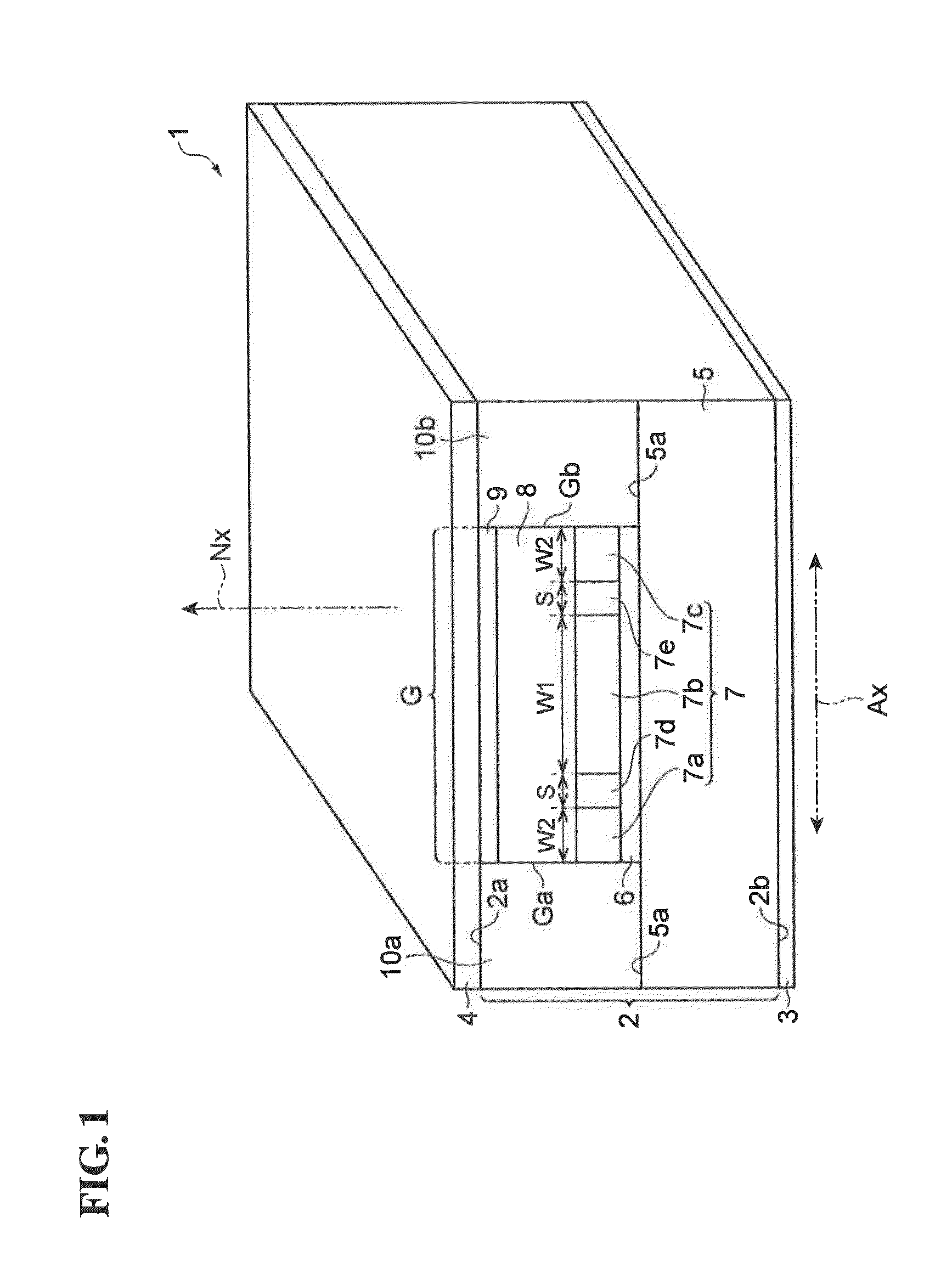Quantum cascade laser
a laser and quantum cascade technology, applied in the direction of laser details, laser optical resonator construction, semiconductor lasers, etc., can solve the problems of difficult to change the emission wavelength in a wide wavelength range, difficult to realize a broad gain spectrum, and heat generated in the central region of the qcl device is not easily dissipated, etc., to achieve good characteristics, low absorption coefficient, and high resistance to electrons
- Summary
- Abstract
- Description
- Claims
- Application Information
AI Technical Summary
Benefits of technology
Problems solved by technology
Method used
Image
Examples
first embodiment
[0046]FIG. 1 illustrates a quantum cascade laser 1 according to the first embodiment. FIG. 1 illustrates an external shape of the quantum cascade laser 1 and an internal structure of the quantum cascade laser 1 in a plane that is perpendicular to a waveguide (that is, a plane defined by a normal direction Nx and a reference direction Ax described later). The quantum cascade laser 1 includes a semiconductor layer 2, a lower electrode 3, and an upper electrode 4. The lower electrode 3 is provided on a back surface 2b of the semiconductor layer 2. The upper electrode 4 is provided on a principal surface 2a of the semiconductor layer 2. The semiconductor layer 2 of the quantum cascade laser 1 includes an n-type semiconductor substrate 5, a mesa waveguide Q a current blocking layer 10a, and a current blocking layer 10b. The mesa waveguide G is provided on a principal surface 5a of the n-type semiconductor substrate 5. The lower electrode 3 is provided on a back surface of the n-type semi...
second embodiment
[0096]In the first embodiment, the buried regions made of a semi-insulating semiconductor are formed in only the light emitting region. In the embodiment, the buried regions are extended from the light emitting region toward outside in the normal direction of the principal surface of the n-type semiconductor substrate and in a direction opposite to the normal direction so as to protrude from the light emitting region.
[0097]In a quantum cascade laser 101 shown in FIG. 6A, buried regions (buried regions 71d and 71e) are extended from a light emitting region 7 to middle portions of upper and lower cladding layers (an n-type lower cladding layer 61 and an n-type upper cladding layer 81. Alternatively, as in a quantum cascade laser 102 shown in FIG. 6B, buried regions (buried regions 72d and 72e) may be extended from a light emitting region 7 to a substrate 5 through the lower cladding layer (an n-type lower cladding layer 62) and to an n-type contact layer 9 through the upper cladding l...
third embodiment
[0104]In each of the first and second embodiments above, as a current confinement structure, the QCL device includes a BH structure including current blocking layers formed of a semi-insulating semiconductor such as Fe-doped InP. However, the current confinement structure is not limited thereto. For example, in a quantum cascade laser 105 shown in FIG. 8, an insulating film 11a and an insulating film 11b are formed on side surfaces Ga and Gb of a mesa waveguide G, respectively as the current confinement structure.
[0105]The quantum cascade laser 105 shown in FIG. 8 includes a semiconductor layer 25. The semiconductor layer 25 includes an n-type semiconductor substrate 5 and a mesa waveguide G. However, the semiconductor layer 25 does not include the current blocking layers 10a and 10b that the semiconductor layer 2 includes in the first embodiment. The insulating films 11a and 11b are each another example of the current blocking layer. The insulating films 11a and 11b may each be for...
PUM
 Login to View More
Login to View More Abstract
Description
Claims
Application Information
 Login to View More
Login to View More - R&D
- Intellectual Property
- Life Sciences
- Materials
- Tech Scout
- Unparalleled Data Quality
- Higher Quality Content
- 60% Fewer Hallucinations
Browse by: Latest US Patents, China's latest patents, Technical Efficacy Thesaurus, Application Domain, Technology Topic, Popular Technical Reports.
© 2025 PatSnap. All rights reserved.Legal|Privacy policy|Modern Slavery Act Transparency Statement|Sitemap|About US| Contact US: help@patsnap.com



